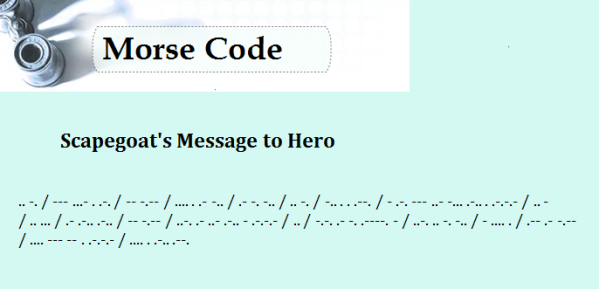~Otto Rank
The Scapegoat's Guide Has Begun
Confounding variables are directly proportionate to level of attention received from family.
Scapegoats communicate with their lost children consistently and they contact hero siblings when they feel ready to return to the pale. Because scapegoats boomerang between the pale and the beyond, their communication with siblings is erratic. While beyond the pale, they have been known to use Dead Letter Boxes – hiding places for bulky objects usually found in holes in ground, rotten tree branches or yard waste – to communicate with lost children and occasionally clowns.
They have been known to use Morse Code to contact heroes when they are ready to return to the pale.

This Morse Code Translator is useful when those unfamiliar with Morse Code attempt to interpret these desperate pleas.
Persona: an outer personality presented to others by an individual. This is often a response to pale demands for “normal” behavior, but is known to inspire deviant behavior in scapegoats.
The more frequently the scapegoat identifies with her deviant image, the more likely she is to displays dark qualities her hero sibling suppresses. Scapegoats are therefore drawn to ghettos and labeled tramps, habitual thieves, lost causes, welfare cases, alcoholics, sellouts, or vandals.
Attempts to emulate the hero are thwarted by the terrible father, who dismisses any good deeds as hypochrondriachal complaining.
Feeling bad, wrong, and disliked, these once gentle scapegoats fall into the shadows, becoming fearful and engaging in promiscuous behavior, drugs that deprave, petty acts of larceny, and vandalism.
The scapegoat is closest to the hero, with whom she communicates the least. Her polar opposite, the hero appears as the scapegoat’s shadow double – a soul-mate of intense warmth and closeness whom she can only aspire to become.
Afflictions include:fits of mental derangement. Behaviors that may include abnormal sensibility to cold, inordinate sexual appetite, setting out to go some place and returning without actually going anywhere, and morbid sleep conditions.
Reference
Rank, O. (1941). The double as immortal self. Beyond Psychology. Dover, New York.
The Scapegoat's Guide Has Begun
The Scapegoat is the child the family feels most ashamed of. A romantic who becomes cynical and distrustful, this child’s departure from the pale could be premeditated attempt to gain negative attention. The Scapegoat may dislike going beyond the pale, so in dreams, he will show in ghettos, as a welfare case, an invalid, crippled or diseased.
Confounding variables are directly proportionate to level of attention received from family.
The unfortunate scapegoat is characterized by deviant behavior. This status is often conferred by observers, and a scapegoat’s acceptance of this label frequently leads to career deviance. Behaviors include Criminal Connections, Possession of Untraceable Weapons, Loitering Place to Place, Loitering in Restrooms, Vagrant loitering in Public Places, and Not Conforming to Rules or Regulations.
Most encounters with police involve Receiving Stolen Property and Criminal Mischief.
Scapegoats are known to carry the following Individual Protective Devices: sling shots, night vision goggles, dart rifles, and Molotov cocktails.
Both within and beyond the pale, they are likely to communicate by using symbols like those below:
Both within and beyond the pale, they are likely to communicate by using symbols like those below:
Scapegoats communicate with their lost children consistently and they contact hero siblings when they feel ready to return to the pale. Because scapegoats boomerang between the pale and the beyond, their communication with siblings is erratic. While beyond the pale, they have been known to use Dead Letter Boxes – hiding places for bulky objects usually found in holes in ground, rotten tree branches or yard waste – to communicate with lost children and occasionally clowns.
They have been known to use Morse Code to contact heroes when they are ready to return to the pale.

This Morse Code Translator is useful when those unfamiliar with Morse Code attempt to interpret these desperate pleas.
Persona: an outer personality presented to others by an individual. This is often a response to pale demands for “normal” behavior, but is known to inspire deviant behavior in scapegoats.
The more frequently the scapegoat identifies with her deviant image, the more likely she is to displays dark qualities her hero sibling suppresses. Scapegoats are therefore drawn to ghettos and labeled tramps, habitual thieves, lost causes, welfare cases, alcoholics, sellouts, or vandals.
Attempts to emulate the hero are thwarted by the terrible father, who dismisses any good deeds as hypochrondriachal complaining.
Feeling bad, wrong, and disliked, these once gentle scapegoats fall into the shadows, becoming fearful and engaging in promiscuous behavior, drugs that deprave, petty acts of larceny, and vandalism.
The scapegoat is closest to the hero, with whom she communicates the least. Her polar opposite, the hero appears as the scapegoat’s shadow double – a soul-mate of intense warmth and closeness whom she can only aspire to become.
Afflictions include:fits of mental derangement. Behaviors that may include abnormal sensibility to cold, inordinate sexual appetite, setting out to go some place and returning without actually going anywhere, and morbid sleep conditions.
Scapegoats are known to carry the following Individual Protective Devices sling shots, night vision goggles, dart rifles, and Molotov cocktails.
Reference
Rank, O. (1941). The double as immortal self. Beyond Psychology. Dover, New York.


Your writing is brilliant. Absolutely brilliant.
ReplyDelete